AGRONOMIC UPDATE – AUGUST 6, 2021….those SMOKY days of summer….
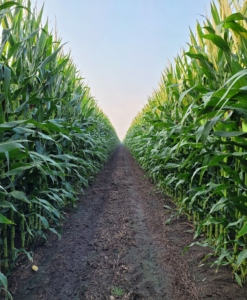
Topics:
– Growing Degree Unit Update
– What’s Going On In My Fields?…..Corn Development, Sunlight, Crop Water Use, Disease, etc….
– Corn/Soybean Insect Update
– Soybean Development – Disease and more…
GROWING DEGREE UNIT UPDATE
As of August 5th, we have accumulated approximately the following for Growing Degree Days in 2021:
Planting Date GDU’s2021 Average GDU Departure from average
April 24 1941 1772 +169 (+7 days)
April 30 1887 1735 +152 (+6 days)
May 6 1808 1699 +109 (+4 days)
We have gained one day in GDU’s since the last update on July 21st. Temperatures have been normal since the last update for the most part, so we have stayed steady to gained a little. Heat continues to be forecasted (see maps below) over the next couple of weeks.
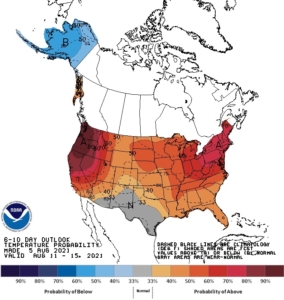
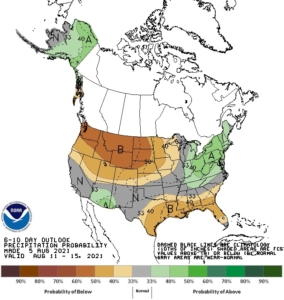
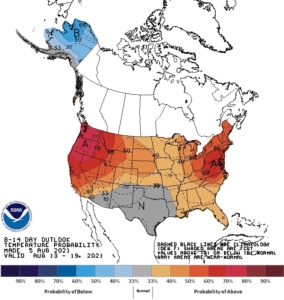
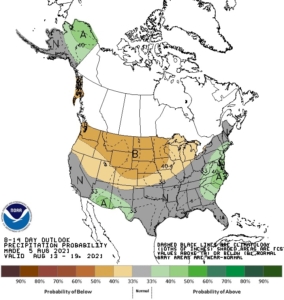
The above maps are the latest 6-10 & 8-14 day forecast maps for temperature and precipitation. You can see that above normal heat and below normal precip is predicted for the next two weeks and forecasts are calling for temps into the 90’s over the next 10-14 days…..however, if the smoke continues to hang around like it has the past 7-10 days, the temps will not get as warm as predicted.
WHAT’S GOING ON IN MY FIELDS?….
- Crop Development – Much of the corn crop is in the R3 (Milk) stage. At this stage, there are approximately 40-50 days left of the growing season, so the key question now is, what can we do to maintain and/or increase overall yield?….finish strong!….
- At Milk stage, the kernels are now well into their rapid rate of dry matter accumulation and are about 80% moisture. Final yield depends upon number of kernels that develop and the final size or weight of the kernels. Although not as severe as at R1, stress now can still have a profound effect on yield by reducing both of these.
- Kernel abortion from stress can occur through the Milk stage(18-22 days after silking), however when the plant reaches Dough, kernel abortion will no longer take place, and any yield reduction from then on out will be from lower test weight. The next 7-10 days will show what effect from stress, like reduced sunlight or water or lack of N, will have on ear tip back. Keep in mind that some hybrids have a ‘normal’ ear tip back anyway but still maintain adequate kernel count.
- So far much of the crop looks pretty good. There are fields where the July 9th wind storm caused a reduction in ear size, zipper ears and spotty pollination, but overall the crop seems in good shape for the most part…..P1082AM in area field….
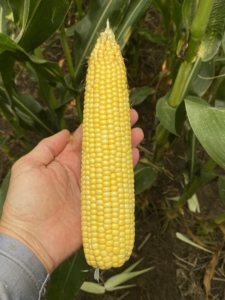
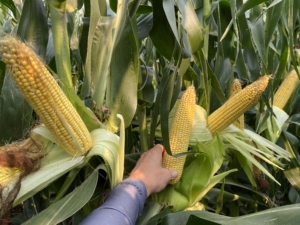
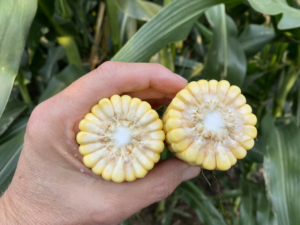
- Sunlight – As hard as it may seem to believe, considering all of the haziness we have experienced over the past 10 days, sunlight intensity is not that far off from the average. Since pollination (past 21 days) sunlight is off only 1-2%….for the past 14 days, sunlight is off 3%….and for the past 7 days, sunlight is off 6% from the 30-year average. Looking at the data, there have been other years in the past 10 that have seen less sunlight than 2021 in this time frame. Here are a couple of charts referencing this:
-
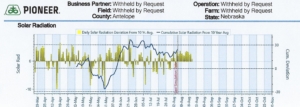
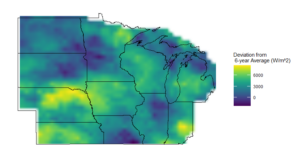
- The first chart shows sunlight for a plot in our area. Notice that overall sunlight since July 19th (pollination) has, for the most part, been normal to slightly above normal over the 10-year average. The second chart shows sunlight deviation over the past six years for the cornbelt for the last two weeks of July 2021. Blue indicates below-average solar radiation due to clouds or smoke. Yellow areas are greater sunlight than the past six years. Note the bright yellow band over the north and northeast of Nebraska….sometimes it’s better to be lucky than good….and we have maybe been lucky versus the rest of the cornbelt. Here is a twitter link that shows a time-lapse video of the second chart…https://twitter.com/ranaedietzel/status/1422317322212098055?s=10
- It is still to early to tell what effect, if any, this will have on final yield. However, the safe bet, is that this will, at the minimum, impact late-season stalk quality. We will update this as the year progresses. Here is a another chart showing results from a shading study…..
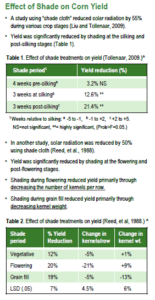
- Crop Water Use – At Milk stage, the corn crop is still under high ET demand. ET rates of .25-.30″/day are typical under hot, dry conditions. ET rates over the past two weeks have averaged .20-.24″/day. Over the next 40-50 days, water will become the #1 management practice to maintain yield. We are hearing more reports of wells starting to lose pressure or need column added, especially to the NW of Elgin.
- With the dry conditions, we are seeing some of the following start to show up in area fields…..irrigation coverage being reduced in fields with low drop nozzles, especially with the taller than average corn this year. For best coverage, drop nozzles should not be any lower than the truss of the irrigation tower. Also seeing the upper canopy get ‘beat up’ from the drops…..satellite imagery is starting to show reduced coverage from irrigation due to plugged nozzles and/or spans….rainfall tends to ‘hide’ these issues, but we are not getting that right now. Bottom line is…. there is still a lot of irrigating left to do if no rain.
- Disease – Still not seeing much for leaf disease in the crop. The upper canopy is staying pretty clean so far. What we are observing is new lesions of Grey Leaf Spot and Bacterial Leaf Streak has increased over the past few weeks, but still less incidence than the past few years. We have found our first Southern Rust as well. We will continue to monitor for outbreaks over the next few weeks.
CORN/SOYBEAN INSECT UPDATE….
- Western Bean Cutworm flight has pretty much come to an end as of the first of August. We are seeing some outbreaks in untreated fields, but overall pressure has not been heavy this year.
- Corn Rootworm adult beetles continue to show up in area fields. Corn rootworm pressure and numbers have been much higher this year versus the past few years. If looking at 4 or more years of continuous corn, continue to monitor for the adults in case a second treatment is warranted to help control for next year.
- Overall insect pressure in soybeans has continued to be low. Bean Leaf Beetle is causing some light defoliation, but not a concern. Have not observed any Soybean Aphids yet.
SOYBEAN DEVELOPMENT…..
- The soybean crop has been moving right along. Much of the area is in the R5 (Beginning Seed) stage with some early planted, early maturity varieties in the early R6 (Full seed) stage.
- Soybean plant height is on the tall side this year. We are starting to see more areas of lodged beans over the past week or so.
- We are starting to see more White Mold and SDS show in area fields now. Expect to find White Mold in the lodged areas especially. It is now a race to see if the soybeans move along faster than the disease.
- ET rates for soybeans will continue to be high through the R6 stage. Soybeans ET rates are now higher than corn. See table….
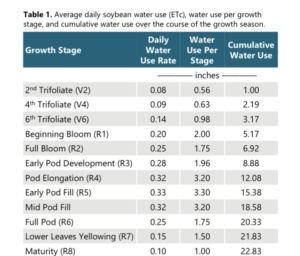
- One will need to be careful not to water constantly to help reduce disease potential due to a constantly ‘wet canopy’. If White Mold becomes a problem, it will be best to water at night and leave off during the day so the canopy has some chance to dry out. In heavy soils, when irrigation is needed, we recommend running a heavy irrigation amount (.80 to inch) and then leaving it sit for a while.
PIONEER CUSTOMER APPRECIATION SUPPER….
The Pioneer Customer Appreciation Supper is Friday evening, August 20th at the Pioneer Warehouse in Elgin, NE. Help us celebrate our 25 year anniversary as we thank you, our customer, for all the great support you have given us over the past 25 years!
Please contact us with any questions or comments you may have! Thank you for your business!!
Starman Seed Service, Inc.

